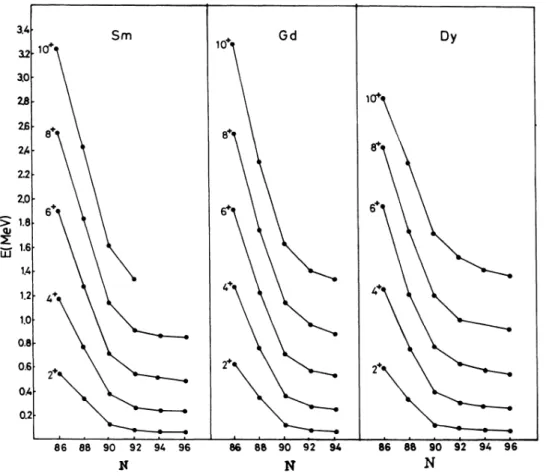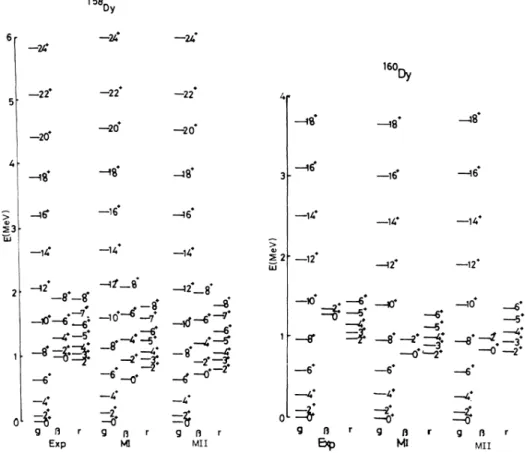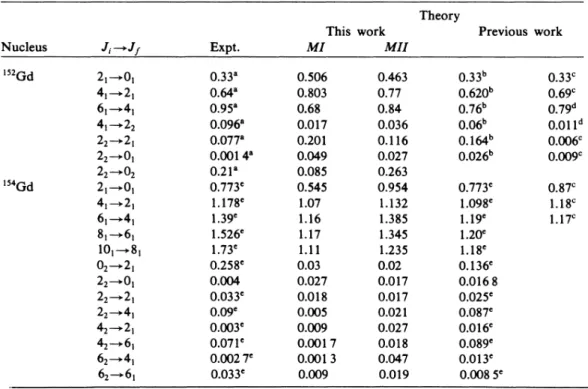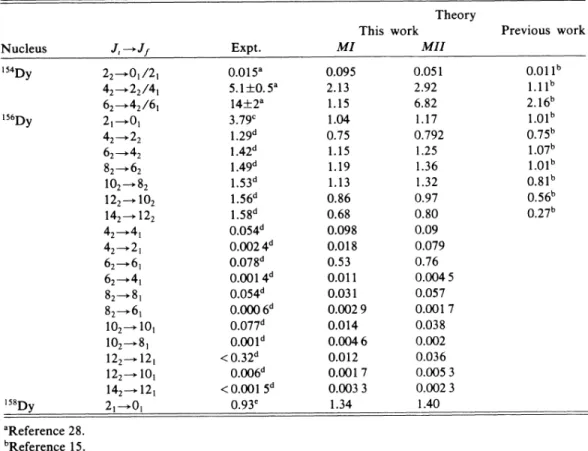PHYSICAL REVIEW C VOLUME 42, NUMBER 1 JULY 1990
Effective boson
number
calculations near the
Z
=64
subshell
C.
S.
Han andD.
S.
ChuuDepartment ofElectrophysics, National Chiao Tung University, Hsinchu, Taiwan, Republic
of
ChinaS.
T.
HsiehDepartment ofPhysics, National Tsing Hua University, Hsinchu, Taiwan, Republic
of
China (Received 21 November 19&9)The effect ofthe partial subshell closure near Z
=64
is studied byintroducing the effective bosonnumber in the framework ofthe interacting boson model. The energy spectra and the
8
(E2)valuesofthe Sm, Gd, and Dy isotope series are calculated. It isfound that the agreements between the theoretical results and the observed data arevery satisfactory when the partial closure effect is taken into account byasmooth variation ofthe effective proton-boson numbers.
I.
INTRODUCTIONIn recent years there are considerable interests in
studying the subshell closure effects at
Z
=64.
'
It
has been shown ' that theZ
=64
subshell had significant effect for N~
88 transition nuclei, but disappears asN ap-proaches90
due to the increasing importanceof
the n-pinteractions. This subshell closure also introduces significant effects on the calculations using the interacting boson model
(IBA).
InIBA,
the numberof
active bosonsis usually determined by counting particles above, or below the nearest spherical-shell closure. Therefore, the counting
of
the boson numbers becomes ambiguous whensome subshell closure exists. Wolfet
al.
have calculated the magnetic momentof
the first2+
statesof
the transi-tional nucleiBa,
Nd, Sm, and Gd in the frameworkof
IBA-2,
and Gill etal.
have performed anIBA
calcula-tion nearZ
=64
subshell. They made the assumptionof
a drastic change in the proton-boson numbers at N
=
88, namely, the assumptionof
aZ
=64
shell for N 88and aZ
=50
shell for N~90.
It
is interestingto
note that for those nuclei with N 88 the counting schemes from theZ
=64
subshell yielded better agreement with the experi-mental data. Scholten has proposed a method to calcu-late the numberof
"effective bosons" in a microscopic model.It
is interesting to see that when the numberof
effective bosons is calculated, it does yield a minimumvalue at
Z
=64.
However, the minimum value is about2.
4 insteadof
0
as required by a full closure structure. This means that there is considerable washing outof
the shell closure effect atZ
=64.
A similar result has also been obtained by Maino and Venture using the Nilsson model on the basisof BCS
approximation. Federman and Pittel, Federman etal.
, and Chen etal.
studiedI
the shape transition
of
Zr and Mo isotopes in the frame-workof
a shell model.It
was found that the isospinT
=0
componentof
the n-p interaction is responsible for the onsetof
deformation.It
was suggested that the pro-motionof
the neutron into the h9/2 orbit nearN=90
leads to a concurrent polarization
of
protons into theh»&2 orbit, via the strong npinter-action between parti-cles in spin-orbit partners orbits, and results in an eradi-cation
of
the subshell gap. However, it is well known that the shell-model single particle level spacings are dependent on the model space. Therefore, the assump-tionof
sudden disappearanceof
theZ
=64
subshell at N=88
made by Wolf etal.
and Gill etal.
seemsto
be oversimplified in the sense that itdoes not take the effectsof
partial closureof
Z
=64
and the smooth neutron num-ber dependence into account. In order to investigate these partial subshell closure effects, some preliminary studies''"
on Sm andEr
isotopes withN=86
—96
have been done.It
is found that satisfactory results can be achieved only when smooth variationof
the proton-boson numbers forN&88are considered.In this paper, we present a systematic study on the 148—158Sm 1so—1586d, and 152—1MDy
isotopes
the effects
of
partial closure and the smooth neutron dependence by considering the effective proton-boson numbers inIBA.
Aunified Hamiltonian and anE2
tran-sition operator for each isotope series are used in our cal-culation.II.
MODELIn the calculation
of
energy levels, the most general Hamiltonian with nine parametersof IBA-1
was usedH~=e,
(ss)+ed(dt
d)+
g
—,'&(2L+1)CLX[[d
Xd ]
'X[d Xd]' 'j'
'L=0,2, 4
+(
—')'
v[[d
Xd
]'
'X[d
Xs]'
'+[d
Xs
]''X[d Xd]' 'j'
'+(2)
0'0[[d
Xd
]'
'X[s
Xs]'
'+[s
Xs ]'
'X[d Xd]' 'j'
'+u
[[d
Xs ]'
'X[d Xs]' 'j'
'+
—,'u
I[s
Xst]'
'X[s
Xs]'
'j'
' .For
comparison, two calculations were performed. We first consider the conventionalIBA
(hereafter denoted asMI).
Then the effective proton-boson numbers arein-cluded (hereafter denoted as MII) to investigate the par-tial subshell closure effects
of
theZ
=64
and N=82.
In both models, the numberof
neutron bosons N is count-ed as usual,N„=
—,'(N
—
82) where N is the numberof
neutrons.
For
the proton bosons, N is counted fromZ
=50
closed shell inMI.
However, inMII,
we relax allthe shell closure restriction for the proton boson but maintain the only requirement that they must be integers. Therefore, we try different sets
of
proton-boson numbers for the nuclei in each isotope series in our calculations. Once we chose a setof
N for the isotope series, a least-squares search for the interaction parameters is then car-ried out in the frameworkof
IBA
to fit the experimental dataof
these nuclei.It
was found that the best set forthe effective proton-boson numbers for Sm isotopes is N=2
for ' Sm, N=4
for ' Sm, and N=6
for all other Sm isotopes. The best setof
the effective proton-boson num-bersof
the Gd isotopes is N=2
for ' Gd, N=5
forGd, and N
=7
for all other Gd isotopes.For
Dy iso-topes, the best set isN„=5
for ' Dy, N=7
for ' Dy, and N=8
for all other Dy isotopes.It
is worth noting that for each isotope series, bothMI
andMII
count the same N for N90.
This is consistent with the disap-pearanceof
theZ
=64
subshell for N&90
in this mass region as pointed out in previous works. ' However, thelinear variation
of
N for N 88inMII
for each isotope series manifests the effectsof
the partial closure and smooth neutron number dependence.In the calculations, 71 reliable energy levels in Sm, 94
levels in Gd, and 100levels in Dy isotopes were included in the least-squares fittings.
It
is well known that not all the parameters in the Hamiltonian are linearly indepen-dent. Since we are concerned with excitation energies only, the effectof e,
can be absorbed into ed. Also the parameter uo is kept at zero because it can be absorbed into other parameters. ' The resulting interaction pa-rameters and the overall root-mean-square deviations for Sm, Gd, and Dy isotopes are listed in TableI.
It
isworth noting that unified interaction parameters can be found for each isotope series.It
isalso seen from the table that the parameters change smoothly from Sm isotopes to Dy isotopes. ~'I+&I 0 ~~ cd ~I&+I V 'a V U' cd V 6 0 0 U V bQ CJ V V 0 V 'a cd Q 0 ~1++I4
0 cd CA C@ V C 0 ~& 0 cd40%
OO0
O O%04
OO Ch DO000
0
O0
l OO OO~
M COooo ooo
I I I I I I O O000
000
0 0
evooo
mWt
Q Q000
I I I I I Io0OO0OO
ooo ooo
4N~
0oo
I I I0 0
000
OO cvooo
m t0 0
000
I I I I I I 40 OO M OO oooo ooo
I I I I I IIII.
RESULTS OO DO0
H0
O Q If) OO OO0 0 0
The ground-band levelsof
the Sm, Gd, and Dyiso-topes are shown in
Fig. 1.
We can see that the energy values for eachJ
states change almost linearly for N 88 and become quite flat forX
90.
This is consistent with the onsetof
theZ
=64
subshell effect. Furthermore, the linear fallingof
the energy values for eachJ
state as N goes from 86to 88 seems tojustify the linear variationof
the effective proton-boson numberN„
found inMII
ineach isotope series.
The partial closure effect for
Z
=64
subshell can be in-vestigated by plotting the effective proton-boson numbers versus the numberof
protons for each mass number A as000
282 C.S.HAN, D. S.CHUU, AND S.
T.
HSIEH 42 3.4 10 Gd Dy0.
2'
~ 22 20-W 1S~
1.6X
UJ 1.4~ 1.2~ 1.0 O. S-0.6 OA~ 0.2 I 86 S8 90 92 94 96 N i 86 88 90 92 94 86 88 QO 92 94 96FIG.
1.The general trend ofthe experimental ground-band level energies ofthe Sm,Gd,and Dy isotopes.shown in
Fig. 2. For
A=150,
there is a clear minimumN
=2
occurring atZ
=64.
The nonzero valueof
the minimum indicates that the closureof
theZ
=64
sub-shell is not complete but only partial. This result is con-sistent with that obtained by Scholten as shown in the dashed lineof
the figure. However, in Scholten's result, there is no calculation to study the way the subshell clo-sure will be decreasing as the neutron numberN,
ap-proaches90.
We have also studied this tendencyof
wash-ing out the subshell closure at
Z
=64
as N=90.
This can be clearly seen from the figure that the partial closure effectof Z
=64
starts to decrease as A goes from 152to 154and is completely eliminated at A=156,
where the curve becomes a straight line indicating the spherical clo-sureof
Z
=50
for N~90.
The gradual decreasingof
the partial closure effect in the mass region A=150
—
156 manifests the smooth neutron number dependence due to the increasing importanceof
the n-p interaction.The calculated energy spectra
of
Sm, Gd, and Dy iso-topes compared with the experimental values are shown in Figs. 3—8. In these figures different quasibands are separated in order to have a clear comparison. One can see that the traditionalIBA
(in the columnMB
cannot reproduce well the energy spectraof
these isotopes. The calculated ground state energies inMI
in general have much lower values comparedto
the observed data espe-cially for some higher spin states, except for ' Dy and Dy where the calculated values are higher than theex-8~ A=156 A=154 6 ~ - A=152 4 ~ A=150 2 62 64 66
FIG.
2. The effective proton-boson numbers versus thenum-ber ofprotons for each mass number A. Thy dashed line is
148 Sm 8 4
—
3 2 0 0 Ol 4J~
2 8—
6—
3 g 4 LaJ—
2—
10—
4—
2 8—
2 4—
4 4 «3 m2 8 «4 0 3—
12—
14' 10 ~—
12—
8~
—
5 0—
p' g 0 r Exp—
0 9 g r Ml MII 0—
2—
0 g Q r g Q Exp N—
2 MII 0" g 0 Exp g 0 r g 0 MI MIIFIG.
3. Experimental and calculated energy spectra for ' 'Sm,"
Sm, and'"Sm.
31' 5'S 3 )56' 158 2~ 2
—
12—
3 mo~
—
2'—
12 1p ~ 2' 4—
12 mo—
8—
fp 2'—
0'—
2 1~ 8 B 8—
2. p 0 g 0 r g g r g 0 Exp Ml MII 9 0 r 9 0 g 8 Exp 0~—
4 0 9 Exp Ml MIIFIG.
4. Experimental and calculated energy spectra for"
Sm, ' Sm, and"
Sm.152 3' M2
—
8 W6 4~—
12 H2 4-3—
16 MS M6—
2—
2 -0 ol.~
Exp 4—
2 4 —2—
p' 9 0 MI pL g A MII -6 —4—
3z2. Lal—
2 4—
2 2 2—
2 g 8 r Exp —B 4 —10 —6. -6 -2 g f3 r Ml 4 4 4 —2 0 —4 0 —2 0' g A MII 9 0 Exp wp l2 —6 3—
2' 0 g A Ml284 C. S.HAN,
D.
S.CHUU, AND S.T.
HSIEH 42 15 3r P~4
WO mp~2
7 2—
12—
12—
e
0~o
—
5' i—
6—
10«3
—
8—
2. 1-—
8 m2'—
2~
~—
8—
4—
—
2 0—
5 t—
5 ~ 4 4 4~
—
2—
8' 9 g r Exp—
4 4 2~ 9 8 MI~
4 E'xp MIIFIG.
6. Experimental and calculated energy spectra for"
Gd and'"Gd.
perimental data. The energy spacings calculated in
MI
are also in considerable disagreement with the observed data in theP
band and the y band. Some states are even in reversed order in the y bandof
' Dy. Thus the results manifest that the pureIBA
model is unable to simulate the energy level structure forthe nuclei nearZ
=64.
The reason forthese discrepancies isthat in the calculationof
the nuclei nearZ
=64
with 86 N 96,the introductionof
the neutron-proton interaction will becomeincreasing-ly important when there are more neutrons outside the N
=82
shell, and thus tend to eliminate theZ
=64
sub-shell closure as mentioned above. Hence, it is reasonable to expect that the calculation which includes the proper numberof
proton bosons will yield better results for the energy level fittings. This is indeed true as shown in thefigures (under the column
MII)
where the effective156D &52 +r
—
12'~p
3I M2 3—
16 W4 M2' M2 5 4 0 LLI MQ—
8 2 0' g 9 9 Ex& gI MII 4 4—
7—
2—
4~+
pi (f 9 Q r G(p—
s—
7
4—
2—
0 9 Q r MII Qi Mo'—
6 2-6
~4
WO~0
~&—
8 ~Q—
0' 4—
0 9 8 MIIFIG.
7. Experimental and calculated energy spectra for"
Dy,"
Dy, and ' Dy.1'58 Oy 6-160 5
—
22—
20—
22 4—
20—
20 4r m8 4-~6
3—
16—
16 w6'x3'
YLJ—
14 2'—
8—
8' r 4 7.10~ ~o
~4
~
—
4 Qe 9 Q r Exp—
&6—
14—
8—
10—
8~r
r—
4 o Ml—
16—
14 r—
4 8 r ~~
0 9 Q r MII—
14)
&2—
12 hl r—
10~t
4—
6 9 Q r—
14—
12—
5' 0~4
9 g r h4—
14—
12—
10—
2'. 9 A r MIIFIG.
8. Experimental and calculated energy spectra for'"Dy
and ' Dy.TABLE
II.
8(E2)
values (in e b )and branching ratios for Sm isotopes. TheoryThis work Previous works Nucleus Sm
'"Sm
152S J,~Jf
4)~2)
2(~0)
4i—
+2) 10)~8)
4)~22
2,~0,
23~0
22 +2]23~2]
23—
+41 3)~2)
/4) 3)~2~/2,
2)~0)
4i—
+2i6)~4)
8)~6)
10)~8)
12'—
+10)23~0)
23~2]
23~4)
23~2)
/0, Expt. 0.151 0.25' 0.274053
0435 0447 0.0106b 0.0036 0.0088b 0.27 0.0387 0.0174 0.296b 24+5 0.67 1.017b 1.2' 139' 1 103 1.123" 0.0163d 0.041 7 0.00416 2.44' MI 0.225 0.399 0.355 0.708 0.934 0.70 0.08 0.09 0.0001 0.14 0.005 0.036 0.165 8.54 0.41 0.68 0.88 0.971 0.907 0.826 0.007 0.011 0.002 1.57 MII 0.131 0.20 0.318 0.566 0.609 0.512 0.05 0.021 0.0035 0.11 0.079 0.025 0.342 20.62 0.861 1.197 1.256 1.220 1.131 1.001 0.0102 0.0267 0.0019 2.618 0.275 0.51b 0 139 0.02b 0.02 0.181b 0.024109
434
0.673098
0.41' 0.73' 0.18' 0.008' 0.015' 0.12' 0.029' 0.54' 16.8" 0.75~ 1.0g 0.97g 0.83g286 C. S.HAN,
D.
S.CHUU, AND S.T.
HSIEH 42TABLE
II.
(Continued).Nucleus
J;
—
+Jf
Expt. This work MIMII
Theory Previous works 154sm 156Sm 158S23~21/4
31 21/41 43~21/41 22~02/21 62~41/61 6~~4~/61 82~61/81 8P~62/81 51 41/6121~01
41—
+21 101~81 121~101 23—
+01 23 +2123~4
23~21/0
31~21/41 43—+21/4121~0
11.9' 0 95' 0.088' &860' 0.2' 0.08' 54' &0.06' &58' 0.43' O.922' 1.186d 1497 1.538 1.565 0.013 O.O2' 0.0008 1.56" 2.S' o.oss'
1.22" 1.28" 5.50 0.428 0.0001 50.8 0.081 0.308 128.5 3.59 173.2 0.102 0.657 0.96 1.01 1.05 0.964 0.002 0.012 0.0018 6.0 0.29 0.0013 0.784 0.647 14.28 1.0 0.054 273.7 0.256 0.658 330.8 4.55 175 0.391 0.978 1.364 1.416 1.333 1.212 0.0068 0.018 0.0012 2.65 1.0 0.111 1.089 1.205 'Reference 17. Reference 18. 'Reference 19. Reference 20. 'Reference 21. 'Reference 22. ~Reference 15. "Reference 23.TABLE
III. B(E2)
values (ine b )forGd isotopes. Theory NucleusJ;~Jf
Expt. This work MIMII
Previous work 1526d 1546d21~01
41—+2161~41
41—
+2q 22~21 22~01 2p~02 21—
+01 41 41 81—
+61 101~81
02~21 22~01 2P~21 2P~41 42~21 42 62~41 6q—
+61 0.33' 0.64' 0.95' 0.096' 0.077' 0.0014' 0.21' 0.773' 1.178' 139' 1.526' 173' 0.258' 0.004 0.033' 0.09' 0003' 0.071' 0.0027'0.
033' 0.506 0.803 0.68 0.0170.
2010.
049 0.085 0.545 1.07 1.16 1.17 1.11 0.03 0.027 0.0180.
005 0.009 0.001 7 0.0013 0.009 0.463 0.77 0.84 0.036 0.116 0.027 0.263 0.954 1.132 1.385 1.345 1.2350.
020.
0170.
017 0.021 0.027 0.0180.
0470.
019033
O.62Ob 0.76 O.O6b o.164b O.O26b 0773' 1.098' 119' 1.20' 1.18' 0.136'0.
0168 0.025' 0.087' 0.016' 0.089' 0 013' 0.008 5' 0.33' 0.69' 0.79 O.O11d 0.006' 0.009' 0.87' 1.18' 1.17'Table
III.
(Continued). NucleusJ;~Jg
Expt. This work MI MII Theory Previous work 156g,d23~0]
23 +2]23~4]
31~21
3]~4]
43~2]
43 4] 43 5]~4]
2]~0]
4] 4] 10]~8]
12,—+10,02~2]
22—+0]22~2]
22~4]
42—+2]42~4]
42~6]
23~2]
23~4]
3]~2]
3]~4]
43~2
43~4]
5]~4]
5]~6]
0.00459 0.0 0.001 39 0.0103 0.01 0.001 4 0.01 0.0043 0.0074 0.914' 1.299' 1.470' 1.57' 159' 1.45' 0.029' 0.00316 0.016' 0.018' 0.0061'
0.014' 0.009 1' 0.035 5' 0.003 2' 0.0364' 0.028' 0.007 8' 0.046' 0.029 5' 0.041' 0.005 0.071 0.0043 0.011 0.055 0.0013 0.061 0.0039 0.0011 0.86 1.12 1.29 1.28 1.23 1.22 0.197 0.001 0.0028 0.007 9 0.011 0.003 0.012 0.026 0.0014 0.0028 0.005 0.0025 0.0021 0.0001 0.003 0.0067 0.027 0.0012 0.0082 0.017 0.0048 0.028 0.0036 0.0034 1.04 1.45 1.53 1.50 1.42 1.26 0.124 0.002 3 0.015 0.043 0.045 0.035 0.048 0.023 0.0038 0.008 0.015 0.002 6 0,005 0.0006 0.014 0.0052 0.01' 0.00038 0.0176 0.01 0.0019 0.01 0.00081 0.01 0914' 1.286' 1.38' 1.38' 134' 1.26' 0.025' 0.004 0.006' 0.015' 0.0047' 0.004 8' 0.014 8' 0 0333' 0.0023' 0 037' 0019' 0.011'
0 039' 0.0289' 0.025' 'Reference 24. bReference 25. 'Reference 26 Reference 15 'Reference 272]~0]
23~0]
23~2]
23~4]
43~2]
43—
+4] 43 6122~0
2p 2]22~4]
31 21 3] 4] 4, 2, 42 4]42~6]
5]~4]
5]~6]
43~23 42~22 5]—
+3] 43~2243~3]
1.008' 0.0016' 0.001 2' 0.0071' 0.004' 0.0022' 0 0094' 0.016 9' 0.029' 0.0013' 0.0297' 0.0177' 0.006' 0.04' &0.01' 0.023 5' 0.0194' 137e 0.6' 1.01' 0 037' 0.14' 0.75 0.0005 0.0017 0.06 0.008 0.0082 0.0004 0.031 0.03 0.067 0.0017 0.0058 0.014 0.013 0.034 0.002 0.016 0.25 0.57 0.49 0.504 0.637 1.13 0.013 0.0002 0.018 0.007 0.029 0.0024 0.030 0.057 0.077 0.0012 0.006 0.037 0.018 0.07 Q.OQO8 0.014 1.3 0.48 0.66 0.35 0.67 1.008' 00019e 0.000 4' 0.0034' 0004 7' 0.001 5' 0.0056' 0.0236' 0 039' 00019' 0043e 0.021' 0.009 2' 0.04' 0.0028' Q035e 0.028' 1 13' 0.42' 0 70' 0.0207' 0.16'288 C. S.HAN,
D.
S.CHUU, AND S.T.
HSIEH 42TABLEIV.
B(E)
values (ine'b')
and branching ratios for Dy isotopes. TheoryThis work Previous work Nucleus 154D 156D 158Dy 'Reference 28. Reference 15. 'Reference 25. Reference 29. 'Reference 30.
J,
~Jf
22~0l/2l 42~2~/4l 62 4z/6l2l~ol
42~22 6q~42
10q~82 12'~
102142~
122 42 4l42~2l
62~6l
62~4,
82~8(
102~10)
102~8(
122~
12l122~
10l142~
12( 2l—
+Ol Expt. 0.015' 5.1+0.
5' 14+2' 3.79' 1.29 1.42149
1.53 1.S6' 1.58d 0.054 0.0024 0.078 O.OO14' o.os4d o.ooo6' 0.077" 0.001" &0.32' o.oo6d &0.0015d 093' 0.095 2.13 1.15 1.04 0.75 1.15 1.19 1.13 0.86 0.68 0.098 0.018 0.53 0.011 0.031 0.0029 0.014 0.0046 0.012 0.0017 0.0033 1.34 0.051 2.92 6.82 1.17 0.792 1.25 1.36 1.32 0.97 0.80 0.09 0.079 0.76 0.0045 0.057 0.0017 0.038 0.002 0.036 0.0053 0.0023 1.40 O.O1lb 1.11b 2.16b 1.O1' O.7S' 1.07 1.O1b 0.81 o.s6' O.27'proton-boson number is taken into account. The results
in
MII
show that the calculated ground-band energy lev-els are in good agreement with the observed data. The energy spacingsof
the levels inp
and y bands improvedmuch better. The level ordering in the y band
of
' Dy is also well reproduced.To
test the wave function, we also calculate the elec-tromagnetic transitions. The general formof
theE2
operator was used,
T'
'=a[(d
Xs+s
Xd)'
'+P(dtXd)' ']
(2)The parameters
a
andp
were determined directly from least-squares fittingto
the observed8
(E2)
values. There are abundant observed8
(E2)
data for the Sm, Gd, and Dy isotopes. We have calculated the8(E2)
both inMI
and inMII.
In the calculationof
MII,
itis interesting to note that a unified parametera=0.
165 andp=
—
0.
105 can be found to reproduce the8(E2)
values quite wellfor all the three isotope series. The resulting values
of
a
and
p
obtained in our calculation agree approximately with those obtained in previous works. ' ' A similar calculation is also performed inMI
with unified pararne-tersa=0.
135andp=0.
115.
In general, the results inMII
are much better than those inMI.
TablesII, III,
and IV show the8
(E2)
values and some branchingra-tios. Some results
of
the previous works are also included for comparison.It
can be seen from the tables that our calculated results inMII
are in better agreement with the observed values than those inMI,
especially for the tran-sitions within the ground band.For
the cross band tran-sitions the agreement is also more satisfactory for theMII
calculation.IV. CONCLUSIONS
This paper presents a scheme tostudy the effect
of
sub-shell closure atZ
=64
for the Sm, Gd, and Dy isotopes in the frameworkof IBA.
Wefound that large discrepan-cies occur whenZ
=
50and N=
82 is treated as a closed shell in this mass region. But this discrepancy can be im-proved very much when the partial subshell closure effect atZ
=64
is taken into account. Therefore, in presenting a scheme for calculating nuclei nearZ
=64,
it is neces-sary torecognize not only that there is a subshell closure atZ
=64,
but also that the neutron-proton interaction among nucleons will gradually wash out the subshell gapwhen there are more neutrons outside the N
=82
shell. The existenceof
partial subshell closure causes ambigui-ties in counting boson numbers in the IBA-type calcula-tions. Lacking a precise microscopic counting scheme,effective boson numbers in the phenomenological calcula-tions.
It
is found that the energy spectra and theB(E2)
valuesof
the Sm, Gd, and Dy isotopes can be well ex-plained when the partial subshell closure effect is taken into account by gradually increasing the effective proton bosons asN approaches90.
The resultsof
our phenome-nological calculations indicate that the effective bosonap-proach in
IBA
is a rather encouraging approach.It
may be helpfulto
study the foundationof
this approach in a more microscopic model, such as the shell model which can manifest the effectsof
the n-p interaction explicitly.This work was supported by the National Science Council
of
Taiwan, Republicof
China.'R. F.
Casten, D. D.Warner, D. S.Brenner, andR.
L.Gill, Phys. Rev.Lett. 47,143(1981).A. Wolf, D. D.Warner, and N. Benczer-Koller, Phys. Lett. 158B,7(1985).
R.
L.Gill, R.F.
Casten, D. D.Warner, D. S.Brenner, and W.B.
Walters, Phys. Lett.118B,251(1982).4A. Wolf, Z.Berant, D. D.Warner,
R.
L.Gill, M. Schmid,R.
E.
Chrien, G.Peaslee, H.Yamamoto,J.
C.Hill,F. K.
Wohn,C.Chung, and W.
B.
Walters, Phys. Lett. 123B,165(1983).50.
Scholten, Phys. Lett. 127B,144(1983).G.Maino and A.Venture, Lett.Nuovo Cimento 39,89(1984).
7P. Federman and S.Pittel, Phys. Rev.C 20,820(1979). P. Federman, S. Pittel, and
R.
Campos, Phys. Lett. 82B, 9(1979).
L.M. Chen, S.
T.
Hsieh, H. C. Chiang, and D. S.Chuu, Il Nuova Cimento 101A,185(1989).' S.
T.
Hsieh, H.C.Chiang, M. M.King Yen, and D. S.Chuu,J.
Phys. G 12, L167 (1986).D. S.Chuu, C.S.Han, and S.
T.
Hsieh, Nucl. Phys. A482, 679 (1988).A. Arima and
F.
Iachello, Phys. Rev. Lett. 35, 1069(1975);Ann. Phys. (N.Y.)99,253 (1976);111,201(1978);Phys. Rev. Lett. 40,385(1978);Ann. Phys. (N.
Y.
)123,468(1979);Annu. Rev.Nucl. Part. Sci.31,75(1981).O.Scholten, Ph.D.thesis, University ofGroningen, 1980. '
R.
Bijker, A.E.
Dieperink, O. Scholten, andR.
Spanhoff,Nucl. Phys. A344, 207(1980).
D. S. Chuu, C. S.Han, S.
T.
Hsieh, and M. M. King Yen, Phys. Rev. C 30, 1300 (1984).M. M.King Yen, S.
T.
Hsieh, H.C.Chiang, andD.
S.Chuu, Phys. Rev. C 29,688(1984).R.
M.Diamond,F.
S.Stephens,K.
Nakai, andR.
Nordhagen, Phys. Rev. C 3,344(1971).'
T.
Tamura,K.
Weeks, andT.
Kishimoto, Phys. Rev. C 20, 307(1979).' S.
K.
Bhardwaj,K.
K.
Gupta,J.
B.
Gupta, and D.K.
Gupta, Phys. Rev.C 27,872(1983).K. K.
Gupta, V.P.Varshney, and D.K.
Gupta, Phys. Rev. C 26,685(1982).'J.
Konijn,J.
B.
R.
Berkhout, W. H. A. Hesselink,J.
J.
Van Ruijven, P.Van Nes, H. Verheul,F.
W. N. De Boer, C.A.Fields,
E.
Sugarbaker, P. M. Walker, andR.
Bijker, Nucl. Phys. A373,397 (1982).S.Davydov and V. L.Ovcharenko, Yad. Fiz. 3, 1011 (1966)
[Sov.
J.
Nucl. Phys. 3, 740 (1966)].J.
B.
Wilhelmy, S.G.Thompson,R.
C.Jared, andE.
Cheifetz, Phys. Rev.Lett. 25, 1122 (1970).N.
R.
Johnson,I.
R.
Lee,F.
K.
McGowan,T.
T.
Sugihara, S. W. Yates, and M. W.Guidry, Phys. Rev.C26, 1004(1982).T.
Grotdal,K.
Nybo,T.
Thorsteinsen, andB.
Elbek, Nucl.Phys. A110,385(1968).
K.
Kumar andJ.
B.
Gupta, Nucl. Phys. A304, 295(1978). P. Van Isacker,K.
Heyde, M. Waroquire, andG.
Wenes,Nucl. Phys. A380,383 (1982)~
W. W. Bowman,
T.
T.
Sugihara, andF.
R.
Hamiter, Phys.Rev. C3,1275(1971).
H.




![Table III. (Continued). Nucleus J;~Jg Expt. This workMI MII Theory Previous work 156g, d 23~0]23+2]23~4] 31~213]~4]43~2]434]435]~4] 2] ~0] 4] 4] 10] ~8] 12, — +10, 02~2] 22 — +0] 22~2] 22~4] 42 — +2] 42~4] 42~6] 23~2] 23~4] 3] ~2] 3]~4] 43~2 43 ~4] 5] ~4]](https://thumb-ap.123doks.com/thumbv2/9libinfo/7597021.128425/8.918.160.752.155.1068/table-iii-continued-nucleus-expt-workmi-theory-previous.webp)
